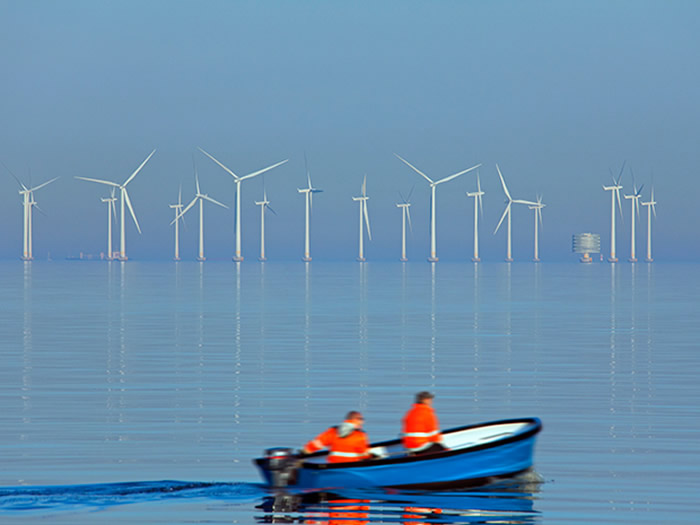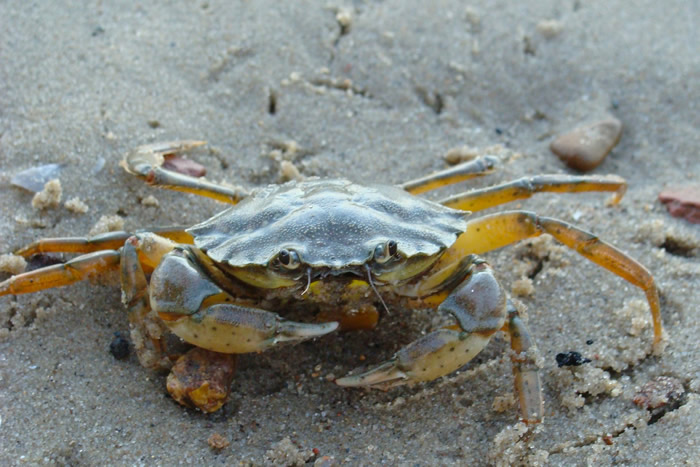Marine biologists get crabby over offshore wind farms
More renewables is all good, right? Not quite. Normally, wind farms get a bad rap for deaths of birds and bats. And they have been the suspected cause of increased sightings of other species such as shore crabs (which could lead to unknown consequences). But now, biologists report (on 25th October in PLoS One) that the Lillgrund farm, Sweden’s largest offshore wind farm, doesn’t seem to harm local marine life.
“Engineers, they don’t think so much about the environment,” says Olivia Langhamer, a Marine Biologist at Chalmers University of Technology in Gothenburg, Sweden. She worked on the study of Lillgrund’s effect on the environment with the Norwegian University of Science and Technology in Trondheim. “It’s really important to discuss with them, what impact you can have so you can modify and you can improve.”
Langhamer points out that there is a delicate biodiversity balance in the marine ecosystem. The relevant food web goes like this: Fish such as cod eat crabs, seals eat the fish, and so forth. But has Lillgrund affected the food chain? After it became operational in 2008, the Swedish Agency for Marine and Water Management noticed that both fish and crabs gather around the turbines’ foundations. The agency’s 2013 report documenting this phenomenon explained why. Stones around the turbines’ foundations—meant to combat erosion from ocean currents—attract crabs. The foundations are like artificial reefs that marine animals can use as protection from predators. But this got Langhammer thinking: Would these artificial reefs upset the crabs’ ecosystem—leading to unexpected consequences? Invasive species, for example, can become dominant species and break the balance in food chains. A 2009 research paper published in PLoS One cited an extreme case where an invasive species probably led to mass extinctions millions of years ago, during during a period known as the Late Devonian extinction.
To find out whether Lillgrund was a hospitable home or a harmful habitat, Langhamer and her colleagues visited Lillgrund and two other sites (Sjollen, which is 13km north of the wind farm; and Bredgrund, 8km south) during the summers of 2011 and 2012. Each of the bodies of water covered about 6,000 meters and had limestone, stone, and sand seabeds at depths between 4 and 9 meters. They also had similarly strong gradients of salinity.
The researchers collected Carcinus maenas shore crabs, which are easy to measure and rank among the world’s worst invasive species. The team caught 3,962 in 2011 and 1,995 in 2012. Crunching numbers, they found that while the crab populations had increased across all three sites, with a slight edge at Lillgrund, there was no statistically significant difference in the total crab numbers, body conditions, sizes, or male-to-female ratios.
Langhamer says one reason for stability in the crab numbers might be because cods are also attracted to the artificial reefs formed by the turbines’ foundations. She suspects that they might be keeping the crab population from exploding.
“Finding no effect could be due to so many reasons,” Magnus Wahlberg, a marine scientist at the University of Southern Denmark in Odense who was not involved in the research, writes in an email. “A large variation between years and sites for reasons we may not know may easily overrule” effects on the crabs.
Langhamer cautions that the work shows only that the wind farms don’t have a net negative effect, and doesn’t indicate whether there is something positive or negative going on behind the scenes.
Others are more optimistic. “We don’t have to worry about the crabs,” says analyst Linus Hammar, who studies the environmental effects of fishing and wind farms at the Swedish Agency for Water and Management. He was also not involved in the new research.
Because fish and seals have also been shown to be attracted to the foundations of wind farms, and the exclusion of animals that are not attracted is “insignificant,” Hammar says the marine ecosystem has stayed essentially in balance. “I think it will even out,” he says.
Langhamer says she hopes to continue studying the effect of renewables on the environment, with a focus on acceptability and the artificial reef effect. She wants to have more collaborations with engineers and the renewable energy industry.
“I think it’s really important to see and study what is happening when you place something in nature,” she says. “What are the risks, what are the mitigations, and what can you improve the design?”
More information: IEEE Spectrum




Comments are closed, but trackbacks and pingbacks are open.